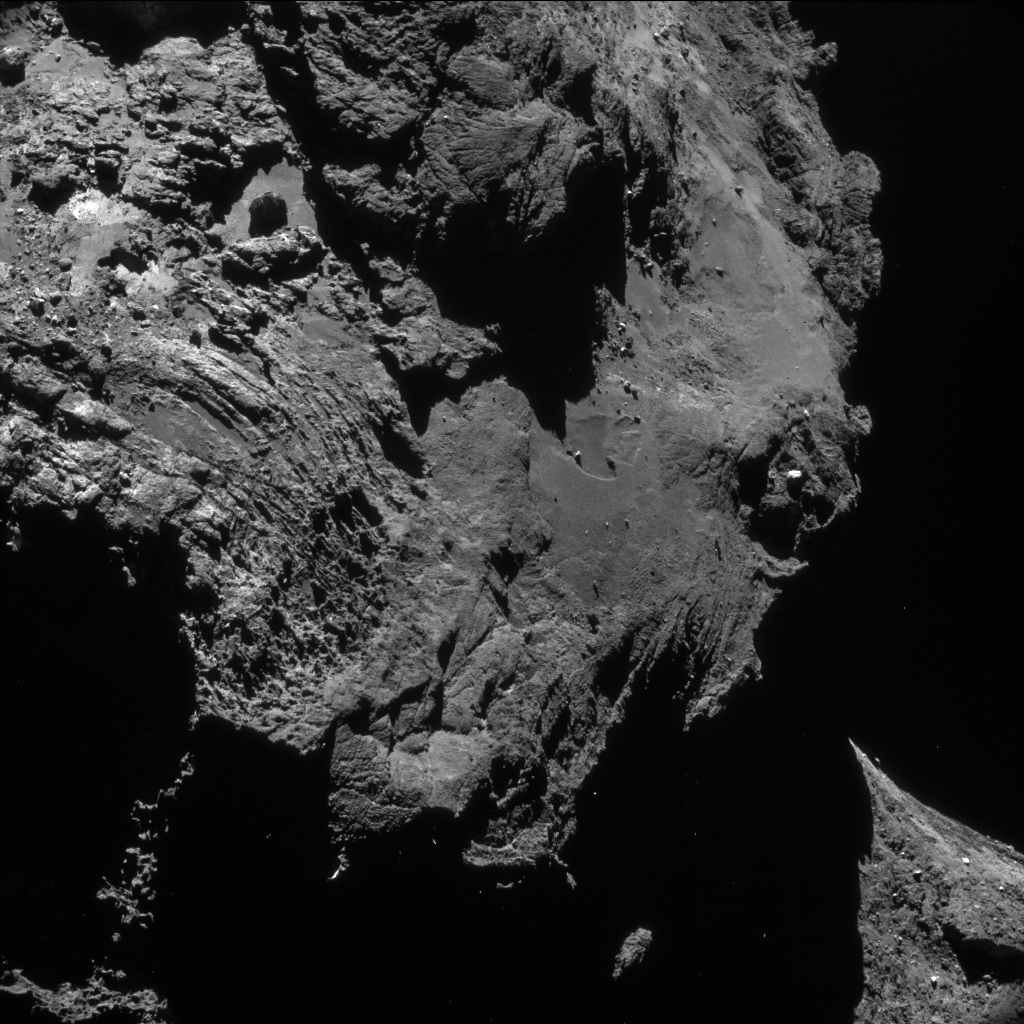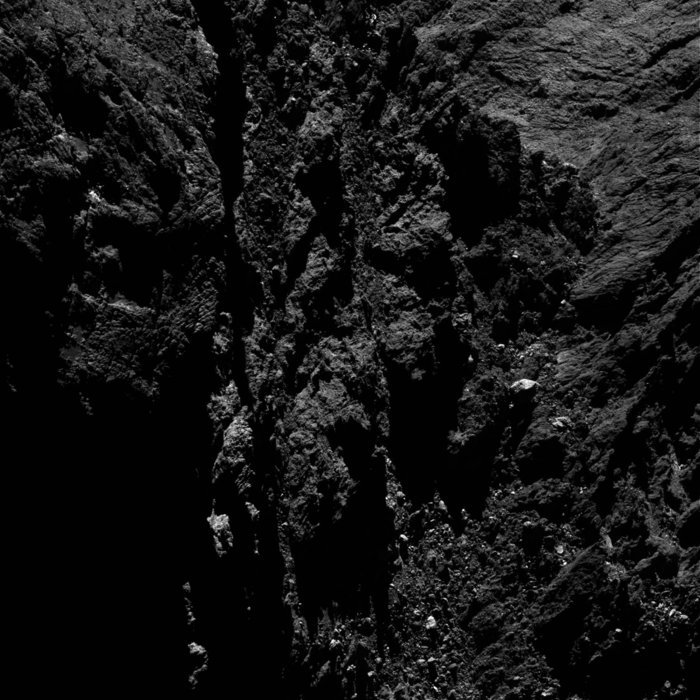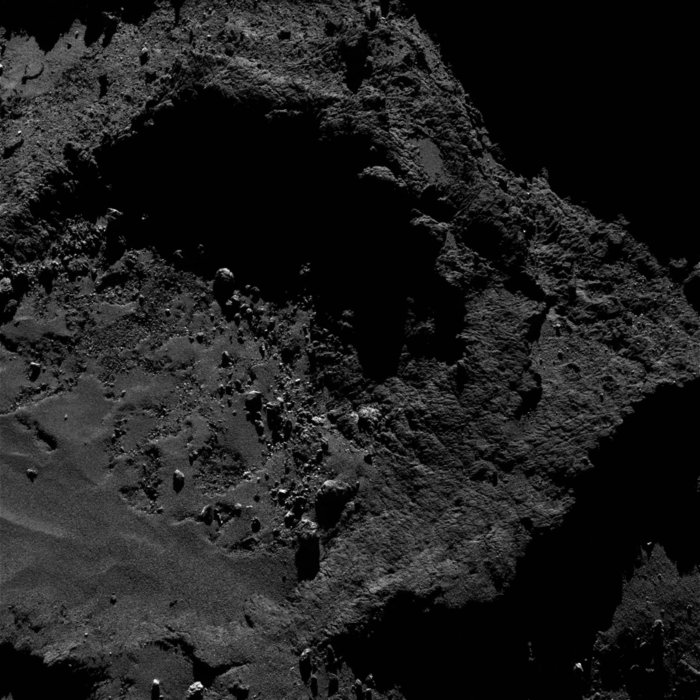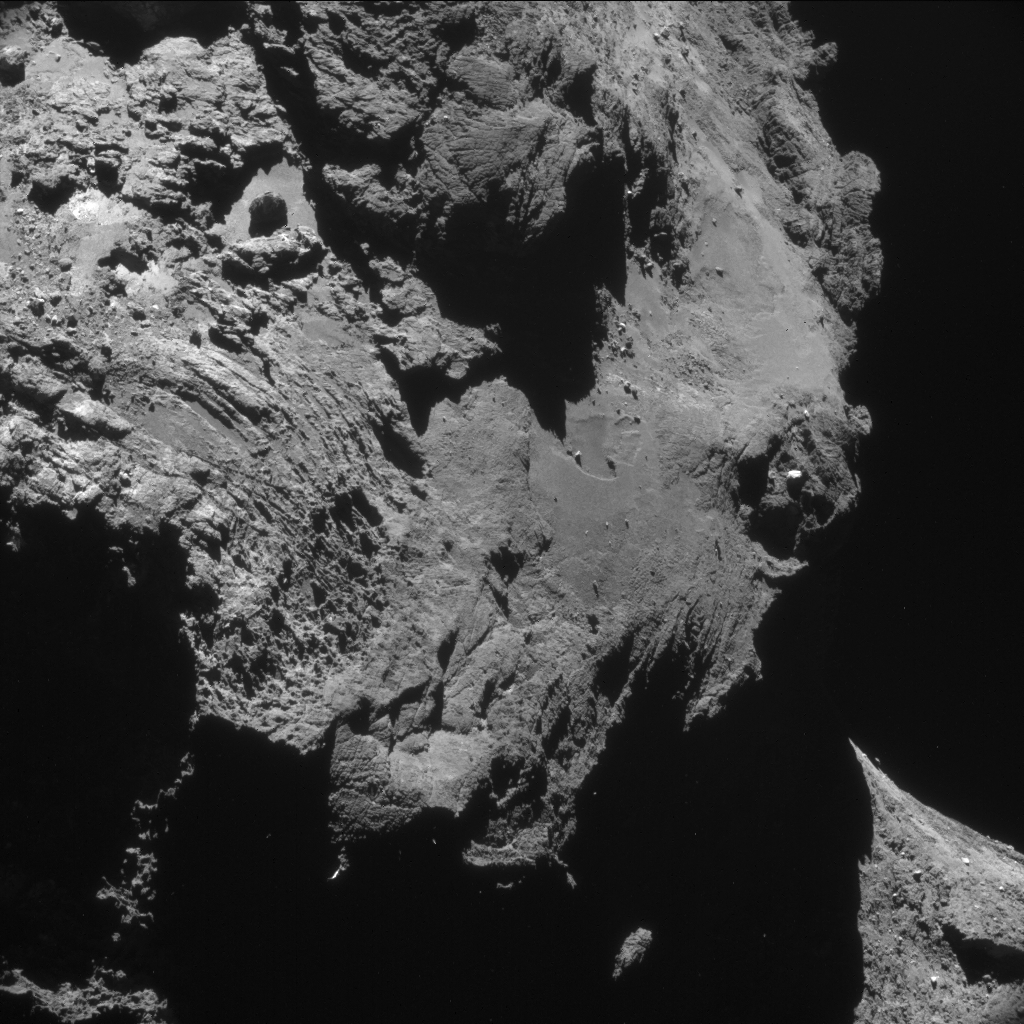This week’s CometWatch is an image taken with Rosetta’s NAVCAM on 1 May 2016, when the spacecraft was 18.8 km from the nucleus of Comet 67P/Churyumov-Gerasimenko.

Enhanced NAVCAM image of Comet 67P/C-G taken on 1 May 2016, 18.8 km from the nucleus. The scale is 1.6 m/pixel and the image measures 1.6 km across. Credits: ESA/Rosetta/NAVCAM – CC BY-SA IGO 3.0
The view shows a portion of the large comet lobe on the left, while hints of the neck and small lobe are visible in the lower right corner. On the large lobe, the image reveals the striking difference between the Atum region, on the left, and Anubis, on the right.
The irregular terrains of Atum display the complex morphology of this region, with depressions, a wealth of linear features and only a few boulders. The adjacent Anubis, instead, is characterised by smooth terrains punctuated with several boulders.
The sharp boundary separating Anubis and Seth is visible on the right edge, and a small portion of Anuket, on the small lobe, can be see in the lower right.
A different perspective is portrayed in this recent image captured by Rosetta’s OSIRIS narrow-angle camera on 3 May. In this orientation, the Wosret region, on the small comet lobe, is visible on the left, declining towards Sobek, on the neck, and further to the large lobe on the right.

OSIRIS narrow-angle camera image taken at 05:43 UTC on 3 May 2016, when Rosetta was 18.8 km from Comet 67P/C-G. The scale is 0.33 m/pixel. Credits: ESA/Rosetta/MPS for OSIRIS Team MPS/UPD/LAM/IAA/SSO/INTA/UPM/DASP/IDA
Another OSIRIS image, taken with the same camera just a few hours earlier, shows a patch of Imhotep, on the large lobe, in staggering detail, uncovering the smooth deposits and boulders that cover this region.

OSIRIS narrow-angle camera image taken at 00:22 UTC on 3 May 2016, when Rosetta was 18.8 km from Comet 67P/C-G. The scale is 0.33 m/pixel. Credits: ESA/Rosetta/MPS for OSIRIS Team MPS/UPD/LAM/IAA/SSO/INTA/UPM/DASP/IDA
The original NAVCAM image is provided below.










Discussion: 12 comments
Getting closer. Some of these images might convince me to buy some photo quality printing paper, and see how they turn out.
On a completely different note, I stumbled across a paper on Arxiv that some will find interesting:
“ORIGIN OF MOLECULAR OXYGEN IN COMET 67P/CHURYUMOV-GERASIMENKO”
O. Mousis, et al.
https://arxiv.org/pdf/1604.08831.pdf
Note that this is a draft, and doesn’t appear to have been submitted to a journal, as yet. Therefore any future published version may be subject to change.
No point giving a lengthy synopsis, as the paper is freely available. It would appear, though, to further strengthen the likelihood of clathrates playing a major role in the formation of 67P.
Thanks for the link Ianw16. Beyond my level, but like a lot what get to understand 🙂
“…Assuming that radiolysis has been the ONLY O2 PRODUCTION MECHANISM, we conclude that the formation of comet 67P/Churyumov-Gerasimenko is possible in a dense and early protosolar nebula…”
There is noticeable erosion and subsidence in the photo of Anubis. I’ve annotated a pre-perihelion photo alongside this one, also annotated, to show the extent of the erosion:
https://scute1133site.wordpress.com/noticeable-erosion-and-subsidence-at-anubis/
Some months ago, over the bar was put the improbability of the ‘kissing’ models… I was wrong.
Nearby dust of similar aerodynamics originating from a same blasting share a very similar kinetics. If well any particular particle can ‘see’ all other around them slowly departing, those don’t inhabit a perfect void, and are subject to far and near blasting echoes which -eventually- turns that slow departing in slow approaching.
ADDING to this, the already commented speculation that dust impacting is imperfectly elastic, bringing translational and rotational temps to a modal [statistic and literal] point .
The bigger the ‘kiss’ accreted particle, the less relevant ‘far and near blasting’ echoes are…
Big ‘kiss’ accretion near a proto-planetary disk should be gravitationally ‘assisted’.
But -still- finding easier to imagine really huge CO2|CO|O2 ‘seeded grow’ at the deep colds of dusty Nebulas.
As Tycho so beautifully shows, ‘blasting echoes’ actually also come from within the same blasting originating the dust, due to the hydrodynamics of the blast.
Fully open from Cornell at
https://arxiv.org/abs/1604.01779
via https://phys.org/news/2016-05-tycho-supernova-remnant-chandra-movie.html
Thinking of Tycho not as an exploding bubble, but as an explosively growing sea urchin. Those ‘spikes’ suddenly pinching the cold ISM, hypersonically compressing [and heating] it.
Speculating Tycho is radially very highly structured.
Now, imagining those sea urchins suddenly ‘trowing away’ all their ‘spikes’. Then no longer ‘the music of the spheres’ but ‘the music of the spikes’ blasts’. This will draw powerful compression surfaces in between those ‘spikes’. Radial to the blasting origin also, honeycomb like [multi-scalar] surfaces.
“Intriguingly, ambient material from the surrounding cloud appears to be squeezing the cores by an amount larger than the gravity of the cores themselves.”
-Dr. Helen Kirk et al., from theNational Research Council of Canada.
This is about cores, a different scale ‘universe’. Is gravity going to be more, or even less relevant at comet formation scales?
via https://phys.org/news/2016-06-reveals-galaxy-pressure-stars.html
Could comets be ‘failed’ core-ization material?
That would give Us a more approximate production estimate.
Molecular Clouds acting as immense Oceans of Life, where creatures are their astronomical objects, from humble grains to shining Stars.
This is just beautiful fiction 🙂
Claudia: There is a difference between the lighter shaded Atum at bottom and the darker shaded Atum towards the top of the picture, which looks like frozen lava. There is also a curious outcrop, apparently of the darker shade, which with its shadow could be mistaken for a representation of Batman. (I hasten to say that I am no geologist.) Are the shade differences real?